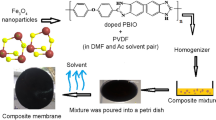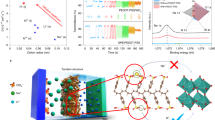Abstract
Smart proton conductive metal-organic framework (MOF) membranes with dynamic remote control over proton conduction show high potential for use in advanced applications, such as sensors and bioprocesses. Here, we report a photoswitchable proton conductive ZIF-8 membrane by coencapsulating polystyrene sulfonate and graphene quantum dots into a ZIF-8 matrix (GQDs-PSS@ZIF-8) via a solid-confined conversion process. The proton conductivity of the GQDs-PSS@ZIF-8 membrane is 6.3 times higher than that of pristine ZIF-8 and can be reversibly switched by light due to photoluminescence quenching and the photothermal conversion effect, which converts light into heat. The local increase in temperature allows water molecules to escape from the porous channels, which cuts off the proton transport pathways and results in a decrease in proton conductivity. The proton conductivity is restored when the light is off owing to regaining water molecules, which act as proton carriers, from the surroundings. The GQDs-PSS@ZIF-8 membrane responds efficiently to light and exhibits an ON/OFF ratio of 12.8. This photogated proton conduction in MOFs has potential for the development and application of MOF-based protonic solids in advanced photoelectric devices.

摘要
可遥控的智能质子传导金属有机骨架(MOFs)薄膜在传感和生物过程等领域具有诱人的应用前景. 本文通过固态限制转换方法将聚苯乙烯磺酸(PSS)和石墨烯量子点(GQDs)共同封装到ZIF-8中, 成功制备了具有光控质子传导特性的ZIF-8薄膜(GQDs-PSS@ZIF-8). GQDs-PSS@ZIF-8膜的质子电导率是ZIF-8膜的6.3倍, 并且实现了其质子电导率的光可逆控制. 其机理主要是在荧光猝灭和光热转换效应下光能被转换为热, 使膜局部温度升高, 水分子从多孔通道中逸出, 从而切断质子传输路径, 导致质子电导率下降. 光照停止后, 水分子重新回到孔道中, 使质子传导率恢复. GQDs-PSS@ZIF-8膜具有较好的光响应性能, 其开关比为12.8. MOFs中的光控质子传导性能对促进MOF基质子传导固体的发展及其在先进光电设备中的应用具有潜在价值.
Similar content being viewed by others
References
Kanj AB, Chandresh A, Gerwien A, et al. Proton-conduction photomodulation in spiropyran-functionalized MOFs with large on-off ratio. Chem Sci, 2020, 11: 1404–1410
Liang HQ, Guo Y, Shi Y, et al. A light-responsive metal-organic framework hybrid membrane with high on/off photoswitchable proton conductivity. Angew Chem, 2020, 132: 7806–7811
Amdursky N, Wang X, Meredith P, et al. Long-range proton conduction across free-standing serum albumin mats. Adv Mater, 2016, 28: 2692–2698
Horike S, Umeyama D, Kitagawa S. Ion conductivity and transport by porous coordination polymers and metal-organic frameworks. Acc Chem Res, 2013, 46: 2376–2384
Ramaswamy P, Wong NE, Shimizu GKH. MOFs as proton conductors: Challenges and opportunities. Chem Soc Rev, 2014, 43: 5913–5932
Li PZ, Wang XJ, Liu J, et al. A triazole-containing metal-organic framework as a highly effective and substrate size-dependent catalyst for CO2 conversion. J Am Chem Soc, 2016, 138: 2142–2145
Wang Z, Cohen SM. Postsynthetic modification of metal-organic frameworks. Chem Soc Rev, 2009, 38: 1315–1329
He S, Wang H, Zhang C, et al. A generalizable method for the construction of MOF@polymer functional composites through surface-initiated atom transfer radical polymerization. Chem Sci, 2019, 10: 1816–1822
Guo Y, Peng X. Mass transport through metal organic framework membranes. Sci China Mater, 2018, 62: 25–42
Guo Y, Jiang Z, Ying W, et al. A DNA-threaded ZIF-8 membrane with high proton conductivity and low methanol permeability. Adv Mater, 2017, 30: 1705155
Yamada T, Otsubo K, Makiura R, et al. Designer coordination polymers: Dimensional crossover architectures and proton conduction. Chem Soc Rev, 2013, 42: 6655–6669
Heinke L, Wöll C. Surface-mounted metal-organic frameworks: Crystalline and porous molecular assemblies for fundamental insights and advanced applications. Adv Mater, 2019, 31: 1806324
Nagarkar SS, Horike S, Itakura T, et al. Enhanced and optically switchable proton conductivity in a melting coordination polymer crystal. Angew Chem Int Ed, 2017, 56: 4976–4981
Saha R, Mukherjee PS. Chemistry of photoswitching molecules in the confined nanospace of aqueous molecular vessels. Dalton Trans, 2020, 49: 1716–1720
Müller K, Helfferich J, Zhao F, et al. Switching the proton conduction in nanoporous, crystalline materials by light. Adv Mater, 2018, 30: 1706551
Garg S, Schwartz H, Kozlowska M, et al. Conductance photo-switching of metal-organic frameworks with embedded spiropyran. Angew Chem Int Ed, 2019, 58: 1193–1197
Li P, Li Z, Guo Y, et al. Ag-DNA@ZIF-8 membrane: A proton conductive photoswitch. Appl Mater Today, 2020, 20: 100761
Zhou W, Gao X, Liu D, et al. Gold nanoparticles for in vitro diagnostics. Chem Rev, 2015, 115: 10575–10636
Boca SC, Potara M, Gabudean AM, et al. Chitosan-coated triangular silver nanoparticles as a novel class of biocompatible, highly effective photothermal transducers for in vitro cancer cell therapy. Cancer Lett, 2011, 311: 131–140
Xuan Y, Zhang RY, Zhang XS, et al. Targeting N-doped graphene quantum dot with high photothermal conversion efficiency for dual-mode imaging and therapy in vitro. Nanotechnology, 2018, 29: 355101
Tian Z, Yao X, Ma K, et al. Metal-organic framework/graphene quantum dot nanoparticles used for synergistic chemo- and photothermal therapy. ACS Omega, 2017, 2: 1249–1258
Li Z, Guo Y, Ying W, et al. Highly conductive and transparent metal-organic frameworks thin film. Sci China Mater, 2019, 62: 1350–1356
Yang X, Yan D. Direct white-light-emitting and near-infrared phosphorescence of zeolitic imidazolate framework-8. Chem Commun, 2017, 53: 1801–1804
Park KS, Ni Z, Côté AP, et al. Exceptional chemical and thermal stability of zeolitic imidazolate frameworks. Proc Natl Acad Sci USA, 2006, 103: 10186–10191
Barbosa P, Rosero-Navarro NC, Shi FN, et al. Protonic conductivity of nanocrystalline zeolitic imidazolate framework 8. Electrochim Acta, 2015, 153: 19–27
Zhang R, Ji S, Wang N, et al. Coordination-driven in situ self-assembly strategy for the preparation of metal-organic framework hybrid membranes. Angew Chem Int Ed, 2014, 53: 9775–9779
Guo Y, Ying Y, Mao Y, et al. Polystyrene sulfonate threaded through a metal-organic framework membrane for fast and selective lithium-ion separation. Angew Chem Int Ed, 2016, 55: 15120–15124
Biswal BP, Shinde DB, Pillai VK, et al. Stabilization of graphene quantum dots (GQDs) by encapsulation inside zeolitic imidazolate framework nanocrystals for photoluminescence tuning. Nanoscale, 2013, 5: 10556–10561
Mao Y, Li J, Cao W, et al. General incorporation of diverse components inside metal-organic framework thin films at room temperature. Nat Commun, 2014, 5: 5532
Peng X, ** J, Kobayashi N, et al. Time-dependent growth of zinc hydroxide nanostrands and their crystal structure. Chem Commun, 2008, 44: 1904–1906
Peng X, ** J, Ichinose I. Mesoporous separation membranes of polymer-coated copper hydroxide nanostrands. Adv Funct Mater, 2007, 17: 1849–1855
Wang Y, Wang B, Shi H, et al. Carbon nanodots in ZIF-8: Synthesis, tunable luminescence and temperature sensing. Inorg Chem Front, 2018, 5: 2739–2745
Agmon N. The Grotthuss mechanism. Chem Phys Lett, 1995, 244: 456–462
Sadakiyo M, Yamada T, Kitagawa H. Hydrated proton-conductive metal-organic frameworks. ChemPlusChem, 2016, 81: 691–701
Kreuer KD, Rabenau A, Weppner W. Vehicle mechanism, a new model for the interpretation of the conductivity of fast proton conductors. Angew Chem Int Ed Engl, 1982, 21: 208–209
Liu W, Yan X, Chen J, et al. Novel and high-performance asymmetric micro-supercapacitors based on graphene quantum dots and polyaniline nanofibers. Nanoscale, 2013, 5: 6053–6062
Zhu Z, Ma J, Wang Z, et al. Efficiency enhancement of perovskite solar cells through fast electron extraction: The role of graphene quantum dots. J Am Chem Soc, 2014, 136: 3760–3763
Lee J, Aizawa N, Numata M, et al. Versatile molecular functionalization for inhibiting concentration quenching of thermally activated delayed fluorescence. Adv Mater, 2017, 29: 1604856
Acknowledgements
This work was supported by the National Natural Science Foundation of China (21875212), the Key Program of National Natural Science Foundation (51632008), the Major R&D Plan of Zhejiang Natural Science Foundation (LD18E020001), the National Key Research and Development Program (2016YFA0200204) and the Fundamental Research Funds for the Central Universities.
Author information
Authors and Affiliations
Contributions
Author contributions Peng X supervised the project; Fan S performed the experiments, analyzed the results and wrote the manuscript; Wang S, Hussain S and Li Z assisted in the device fabrication and measurement; Ma X, Wang X and Wan X contributed to the theoretical and data analyses. All authors contributed to the general discussion.
Corresponding author
Ethics declarations
Conflict of interest The authors declare that they have no conflict of interest.
Additional information
Shuaikang Fan received his Bachelor degree (2019) from the College of Materials Science and Engineering at Sichuan University. He is currently pursuing his Master degree at the School of Materials Science and Engineering at Zhejiang University under the supervision of Prof. **nsheng Peng. His present research interests mainly focus on the design and syntheses of proton conductive MOF membranes for energy conversion devices.
**nsheng Peng received his PhD degree in 2003 at the Institute of Solid State Physics, Chinese Academy of Sciences. He became a full professor at the School of Materials Science and Engineering at Zhejiang University in 2010. His research interests mainly focus on the design and syntheses of functional membranes and controlled mass transportation in energy and environmental science.
Rights and permissions
About this article
Cite this article
Fan, S., Wang, S., Wang, X. et al. Photogated proton conductivity of ZIF-8 membranes co-modified with graphene quantum dots and polystyrene sulfonate. Sci. China Mater. 64, 1997–2007 (2021). https://doi.org/10.1007/s40843-020-1602-5
Received:
Accepted:
Published:
Issue Date:
DOI: https://doi.org/10.1007/s40843-020-1602-5




